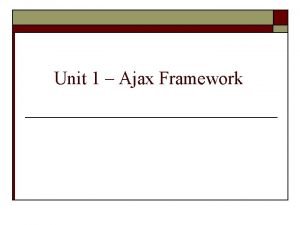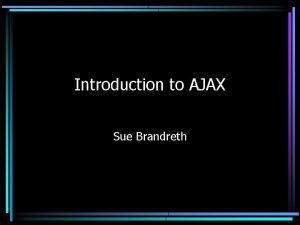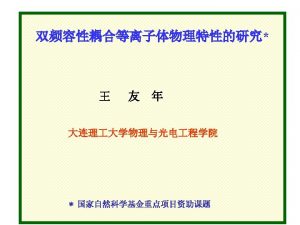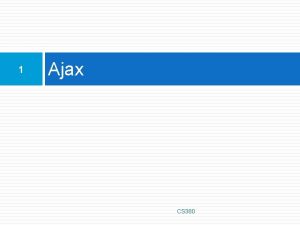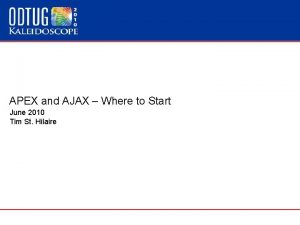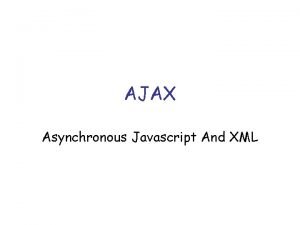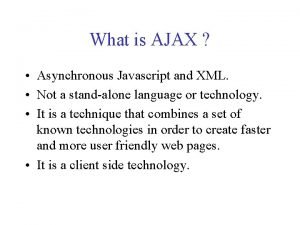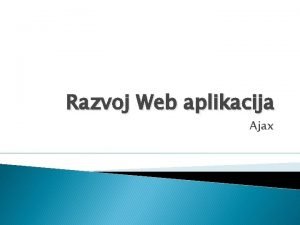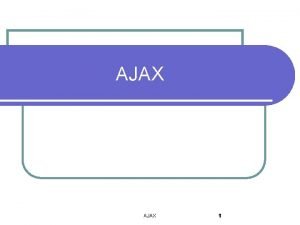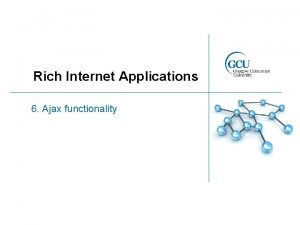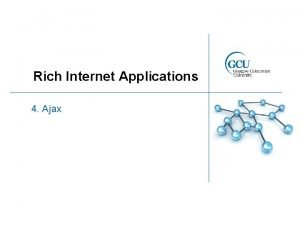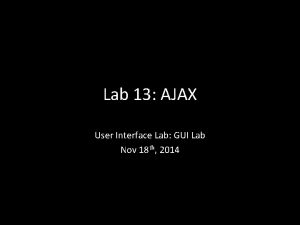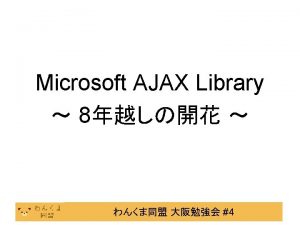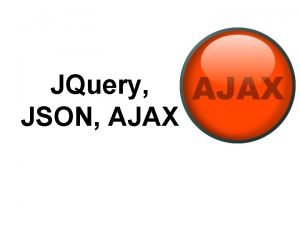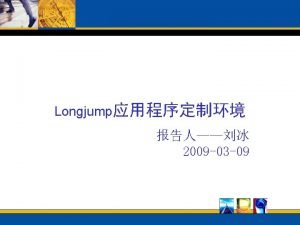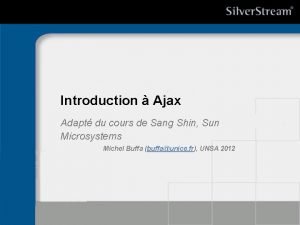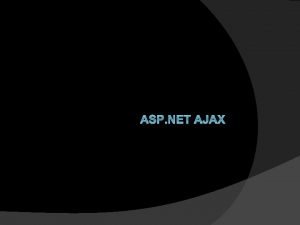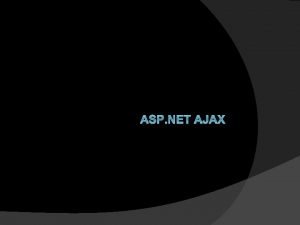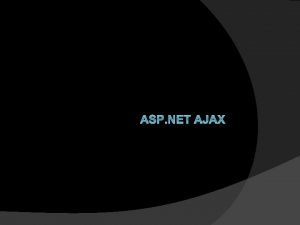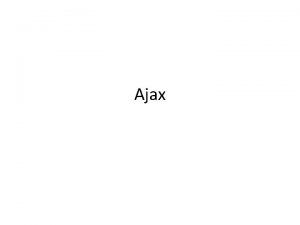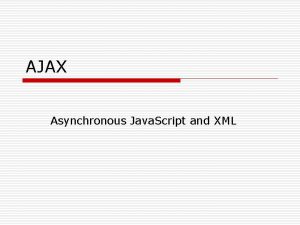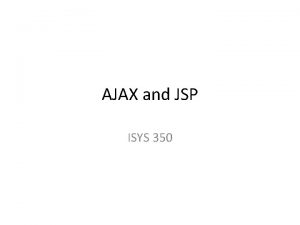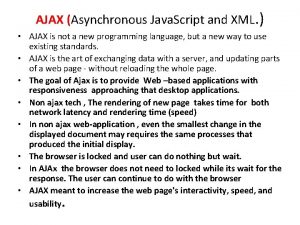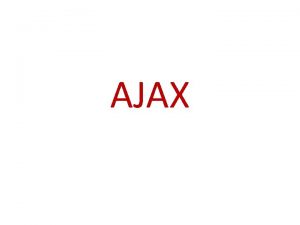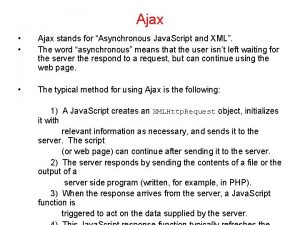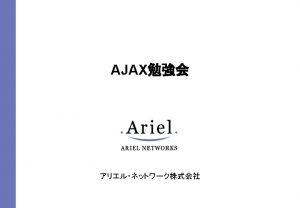Introduction to Ajax Sang Shin Java Technology Architect























































- Slides: 55

Introduction to Ajax Sang Shin Java Technology Architect Sun Microsystems, Inc. sang. shin@sun. com www. javapassion. com

Agenda 1. What is Rich User Experience? 2. Rich Internet Application (RIA) Technologies 3. AJAX: Real-life examples & Usage cases 4. What is and Why AJAX? 5. Technologies used in AJAX 6. Anatomy of AJAX operation 7. XMLHttp. Request Methods & Properties 8. DOM APIs & Inner. HTML 9. AJAX Security 10. Java. Script debugging tools 2

1. Rich User Experience for Web Application

Rich User Experience • Take a look at a typical desktop application (Spreadsheet app, etc. ) • The program responses intuitively and quickly • The program gives a user meaningful feedback's instantly > A cell in a spreadsheet changes color when you hover your mouse over it > Icons light up as mouse hovers them • Things happen naturally > No need to click a button or a link to trigger an 5

Characteristics of Conventional Web Applications (Apps without Ajax) • “Click, wait, and refresh” user interaction > Any communication with the server forces a page refresh • Synchronous “request/response” communication model > The user has to wait for the response • Page-driven: Workflow is based on pages > Page-navigation logic is determined by the server 6

Issues of Conventional Web Application • Interruption of user operation > Users cannot perform any operation while waiting for a response • Loss of operational context during refresh > Loss of information on the screen > Loss of scrolled position • No instant feedback's to user activities > A user has to wait for the next page • Constrained by HTML > Lack of useful widgets These are the reasons why Rich Internet 7

2. Rich Internet Application (RIA) Technologies

Rich Internet Application (RIA) Technologies • • Applet Macromedia Flash/Air Java Web. Start DHTML with Hidden IFrame Ajax Sliverlight (Windows only) Java. FX (Java Platform) 9

Applet • Pros: > Can use full Java APIs > Custom data streaming, graphic manipulation, threading, and advanced GUIs > Well-established scheme • Cons: > Code downloading time could be significant > Reliability concern - a mal-functioning applet can crash a browser • There is renewed interest in applet, however, as a RIA technology with Java SE 10 Update 10 10

Macromedia Flash • Designed for playing interactive movies originally • Programmed with Action. Script • Implementation examples > Macromedia Flex > Laszlo suite (open source) • Pros: > Good for displaying vector graphics • Cons: > Browser needs a Flash plug-in > Action. Script is proprietary 11

Java Web. Start • Desktop application delivered over the net > Leverages the strengths of desktop apps and applet • Pros > > > Desktop experience once loaded Leverages Java technology to its fullest extent Disconnected operation is possible Application can be digitally signed Incremental redeployment • Cons > Old JRE-based system do not work 12

DHTML (Dynamic HTML) • DHTML = Java. Script + DOM + CSS • Used for creating interactive applications • No asynchronous communication, however > Full page refresh still required > Reason why it has only a limited success 13

DHTML with Hidden IFrame • IFrame was introduced as a programmable layout to a web page > An IFrame is represented as an element of a DOM tree > You can move it, resize it, even hide it while the page is visible • An hidden IFrame can add asynchronous behavior > The visible user experience is uninterrupted – operational context is not lost • It is still a hack 14

AJAX • DHTML plus Asynchronous communication capability through XMLHttp. Request • Pros > > Emerges as a viable RIA technology Good industry momentum Several toolkits and frameworks are emerging No need to download code & no plug-in required • Cons > Still some browser incompatibility > Java. Script is hard to maintain and debug • AJAX-enabled JSF components will help 15

3. AJAX: Real-life Examples & Usecases

Real-Life Examples of AJAX Apps • Google maps > http: //maps. google. com/ • Goolgle Suggest > http: //www. google. com/webhp? complete=1&hl=en • Net. Flix > http: //www. netflix. com/Browse. Selection? lnkctr=n mhbs • Gmail > http: //gmail. com/ • Yahoo Maps (new) > http: //maps. yahoo. com/ 17

Key Aspects of Google Maps • A user can drag the entire map by using the mouse > Instead of clicking on a button or something > The action that triggers the download of new map data is not a specific click on a link but a moving the map around with a mouse • Behind the scene - AJAX is used > The map data is requested and downloaded asynchronously in the background • Other parts of the page remains the same > No loss of operational context 19

Usage cases for AJAX • Real-time server-side input form data validation > User IDs, serial numbers, postal codes > Removes the need to have validation logic at both client side for user responsiveness and at server side for security and other reasons • Auto-completion > Email address, name, or city name may be auto- completed as the user types • Master detail operation > Based on a user selection, more detailed information can be fetched and displayed 20

Usage cases for AJAX • Advanced GUI widgets and controls > Controls such as tree controls, menus, and progress bars may be provided that do not require page refreshes • Refreshing data > HTML pages may poll data from a server for up-to- date data such as scores, stock quotes, weather, or application-specific data 21

Demo: AJAX Sample Apps javapassion. com/handsonla bs/ajaxbasics 2/#Exercise_1

Demo Scenario • Run sample AJAX applications within Net. Beans IDE > Auto completion > Data validation > Progress bar • You can try this demo yourself > These applications are provided as part of the hands-on lab. > www. javapassion. com/handsonlabs/4257_ajaxbasi cs 2. zip 23

4. AJAX: What is and Why AJAX?

Why AJAX? • Intuitive and natural user interaction > No clicking required > Mouse movement is a sufficient event trigger • "Partial screen update" replaces the "click, wait, and refresh" user interaction model > Only user interface elements that contain new information are updated asynchronously (no interruption to user operation) > The rest of the user interface remains displayed without interruption (no loss of operational context) • Data-driven (as opposed to page-driven) > UI is handled in the client while the server provides 25

Why AJAX? • Asynchronous communication replaces "synchronous request/response model. " > A user can continue to use the application while the client program requests information from the server in the background > Separation of displaying from data fetching 26

Interrupted user operation while the data is being fetched Uninterrupted user operation while data is being fetched 27

28

5. AJAX: Technologies Used in AJAX

Technologies Used In AJAX • Javascript > Loosely typed scripting language > Java. Script function is called when an event in a page occurs > Glue for the whole AJAX operation • DOM > Represents the structure of XML and HTML documents > API for accessing and manipulating structured documents • CSS > Allows for a clear separation of the presentation style from the content and may be changed programmatically by Java. Script 30

XMLHttp. Request • Java. Script object • Adopted by modern browsers > Mozilla™, Firefox, Safari, and Opera • Communicates with a server via standard HTTP GET/POST • XMLHttp. Request object works in the background for performing asynchronous communication with the backend server > Does not interrupt user operation 31

Server-Side AJAX Request Processing • Server programming model remains the same > It receives standard HTTP GETs/POSTs > Can use Servlet, JSP, JSF, whatever web technologies. . . • With minor caveats > Could have more frequent and finer-grained requests from clients (design issue) > Response content type can be > text/xml > text/plain 32

6. AJAX: Anatomy Of AJAX Interaction using “Data Validation” Sample Application

Anatomy of an AJAX Interaction (Data Validation Example) 34

Steps of AJAX Operation 1. A client event occurs 2. An XMLHttp. Request object is created 3. The XMLHttp. Request object is configured 4. The XMLHttp. Request object makes an async. request 5. The Validate. Servlet returns an XML document containing the result 6. The XMLHttp. Request object calls the callback() function and processes the result 7. The HTML DOM is updated 35

1. A Client event occurs • A Java. Script function is called as the result of an event • Example: validate. User. Id() Java. Script function is mapped as a event handler to a onkeyup event on input form field whose id is set to “userid” <input type="text" size="20" id="userid" name="id" 36

2. An XMLHttp. Request object is created var req; function init. Request() { if (window. XMLHttp. Request) { req = new XMLHttp. Request(); } else if (window. Active. XObject) { is. IE = true; req = new Active. XObject("Microsoft. XMLHTTP"); } } function validate. User. Id() { init. Request(); req. onreadystatechange = process. Request; if (!target) target = document. get. Element. By. Id("userid"); var url = "validate? id=" + escape(target. value); req. open("GET", url, true); req. send(null); } 37

3. An XMLHttp. Request object is configured with a callback function var req; function init. Request() { if (window. XMLHttp. Request) { req = new XMLHttp. Request(); } else if (window. Active. XObject) { is. IE = true; req = new Active. XObject("Microsoft. XMLHTTP"); } } function validate. User. Id() { init. Request(); req. onreadystatechange = process. Request; // callback function if (!target) target = document. get. Element. By. Id("userid"); var url = "validate? id=" + escape(target. value); req. open("GET", url, true); req. send(null); 38

4. XMLHttp. Request object makes an async. request function init. Request() { if (window. XMLHttp. Request) { req = new XMLHttp. Request(); } else if (window. Active. XObject) { is. IE = true; req = new Active. XObject("Microsoft. XMLHTTP"); } } function validate. User. Id() { init. Request(); req. onreadystatechange = process. Request; if (!target) target = document. get. Element. By. Id("userid"); var url = "validate? id=" + escape(target. value); req. open("GET", url, true); req. send(null); } • URL is set to validate? id=greg 39

5. The Validate. Servlet returns an XML document containing the results (Server) public void do. Get(Http. Servlet. Request request, Http. Servlet. Response response) throws IOException, Servlet. Exception { String target. Id = request. get. Parameter("id"); if ((target. Id != null) && !accounts. contains. Key(target. Id. trim())) { response. set. Content. Type("text/xml"); response. set. Header("Cache-Control", "no-cache"); response. get. Writer(). write("<valid>true</valid>"); } else { response. set. Content. Type("text/xml"); response. set. Header("Cache-Control", "no-cache"); response. get. Writer(). write("<valid>false</valid>"); } } 40

6. XMLHttp. Request object calls callback() function and processes the result • The XMLHttp. Request object was configured to call the process. Request() function when there is a state change to the ready. State of the XMLHttp. Request object function process. Request() { if (req. ready. State == 4) { if (req. status == 200) { var message =. . . ; . . . 41

7. The HTML DOM is updated • Java. Script technology gets a reference to any element in a page using DOM API • The recommended way to gain a reference to an element is to call > document. get. Element. By. Id("user. Id. Message"), where "user. Id. Message" is the ID attribute of an element appearing in the HTML document • Java. Script technology may now be used to modify the element's attributes; modify the element's style properties; or add, remove, or modify child elements 42

1. <script type="text/javascript"> 2. function set. Message. Using. DOM(message) { 3. var user. Message. Element = document. get. Element. By. Id("user. Id. Message"); 4. var message. Text; 5. if (message == "false") { 6. user. Message. Element. style. color = "red"; 7. message. Text = "Invalid User Id"; 8. } else { 9. user. Message. Element. style. color = "green"; 10. message. Text = "Valid User Id"; 11. } 12. var message. Body = document. create. Text. Node(message. Text); 13. // if the message. Body element has been created simple replace it otherwise 14. // append the new element 15. if (user. Message. Element. child. Nodes[0]) { 16. user. Message. Element. replace. Child(message. Body, 17. user. Message. Element. child Nodes[0]); 18. } else { 19. user. Message. Element. append. Child(message. Body); 20. } 21. } 43

8. AJAX: DOM API & Inner. HTML

Browser and DOM • Browsers maintain an object representation of the documents being displayed > In the form of Document Object Model (DOM) > It is readily available as document Java. Script object • APIs are available that allow Java. Script code to modify the DOM programmatically 49

DOM APIs vs. inner. HTML • DOM APIs provide a means for Java. Script code to navigate/modify the content in a page function set. Message. Using. DOM(message) { var user. Message. Element = document. get. Element. By. Id("user. Id. Message"); var message. Text; if (message == "false") { user. Message. Element. style. color = "red"; message. Text = "Invalid User Id"; } else { user. Message. Element. style. color = "green"; message. Text = "Valid User Id"; } var message. Body = document. create. Text. Node(message. Text); if (user. Message. Element. child. Nodes[0]) { user. Message. Element. replace. Child(message. Body, user. Message. Element. child. Nodes[0]); } else { user. Message. Element. append. Child(message. Body); } 50

DOM APIs vs. inner. HTML • Using inner. HTML is easier: Sets or retrieves the HTML between the start and end tags of the object function set. Message. Using. DOM(message) { var user. Message. Element = document. get. Element. By. Id("user. Id. Message"); var message. Text; if (message == "false") { user. Message. Element. style. color = "red"; message. Text = "Invalid User Id"; } else { user. Message. Element. style. color = "green"; message. Text = "Valid User Id"; } user. Message. Element. inner. HTML = message. Text; } 51

Do I Have To Use Xml. Http. Request to Write Ajax application?

Ajax Frameworks and Toolkits • In general, you are going to use Ajax frameworks and toolkits • These toolkits provide higher-level API, which hides the complexity of Xml. Http. Request 53

9. AJAX Security

AJAX Security: Server Side • AJAX-based Web applications use the same server-side security schemes of regular Web applications > You specify authentication, authorization, and data protection requirements in your web. xml file (declarative) or in your program (programatic) • AJAX-based Web applications are subject to the same security threats as regular Web applications > Cross-site scripting > Injection flaw 55

AJAX Security: Client Side • Java. Script code is visible to a user/hacker > Hacker can use the Java. Script code for inferring server side weaknesses > Obfustication or compression can be used • Java. Script code is downloaded from the server and executed (“eval”) at the client > Can compromise the client by mal-intended code • Downloaded Java. Script code is constrained by sand-box security model > Can be relaxed for signed Java. Script 56

10. Java. Script Development Tools (Try these tools with “AJAX Basics & Dev. Tools” Hands-on Lab)

Development Tools for Net. Beans IDE • Building AJAX Applications over Net. Beans is not that much different from building regular Web applications • Net. Beans supports Java. Script editor and debugger 59

Development Tools on Mozilla Browser • Mozilla Fire. Bug debugger (add-on) > This is the most comprehensive and most useful Java. Script debugger > This tool does things all other tools do and more • Mozilla Java. Script console • Mozilla DOM inspector (comes with Firefox package) • Mozilla Venkman Java. Script debugger (addon) • Mozilla Live. HTTPHeaders HTTP monitor (similar to Net. Beans HTTP monitor) 60

Mozilla Fire. Bug Debugger • Spy on XMLHttp. Request traffic • Java. Script debugger for stepping through code one line at a time • Inspect HTML source, computed style, events, layout and the DOM • Status bar icon shows you when there is an error in a web page • A console that shows errors from Java. Script and CSS • Log messages from Java. Script in your web page to the console (bye "alert debugging") • An Java. Script command line (no more 61

AJAX Basics Sang Shin Java Technology Architect Sun Microsystems, Inc. sang. shin@sun. com www. javapassion. com
 Ang balagtasan ay binubuo ng ilang panig
Ang balagtasan ay binubuo ng ilang panig Java ajax framework
Java ajax framework Introduction to ajax
Introduction to ajax Ajax introduction
Ajax introduction 同善医院中医部医生
同善医院中医部医生 Dr. elizabeth shin
Dr. elizabeth shin Shin kubota immortal jellyfish
Shin kubota immortal jellyfish Neck parts
Neck parts Shin nakamura chemical
Shin nakamura chemical Osi shin guards
Osi shin guards Wrist taping athletic training
Wrist taping athletic training Nejime definition floral design
Nejime definition floral design Rikkwa
Rikkwa Shin inouye
Shin inouye Ccp 1
Ccp 1 Berthe erica crow character traits
Berthe erica crow character traits Shin sobue
Shin sobue Kim shin jo
Kim shin jo Google maps ajax
Google maps ajax Achilles and ajax playing dice
Achilles and ajax playing dice Ajax stands for
Ajax stands for Dynatrace tool tutorial
Dynatrace tool tutorial Frenotomy ajax
Frenotomy ajax Pinewood women's residential treatment program
Pinewood women's residential treatment program Ajax cs
Ajax cs Sterilization by mechanical methods
Sterilization by mechanical methods Ajax ebrei
Ajax ebrei Microsoft ajax content delivery network
Microsoft ajax content delivery network Wwv_flow.ajax
Wwv_flow.ajax Ajax security issues
Ajax security issues Ajax asynchronous javascript and xml
Ajax asynchronous javascript and xml Asynchronous javascript and xml
Asynchronous javascript and xml Ajax cs
Ajax cs Mia ajax
Mia ajax Ajax
Ajax Dwr ajax
Dwr ajax Ajax mbti
Ajax mbti Ajax.l
Ajax.l Lll
Lll Rich internet applications with ajax
Rich internet applications with ajax Ajax svg
Ajax svg Ajax user interface
Ajax user interface Java sqlite
Java sqlite Slideshare
Slideshare Greek vase shapes
Greek vase shapes Easyajax
Easyajax Ajax scales
Ajax scales Ajax
Ajax Request.onreadystatechange
Request.onreadystatechange Ajax
Ajax 레식 서버 셀렉터
레식 서버 셀렉터 Ajax async
Ajax async Javascript framework
Javascript framework Ajax vandaag
Ajax vandaag Ajax avanzado
Ajax avanzado Ajax
Ajax

